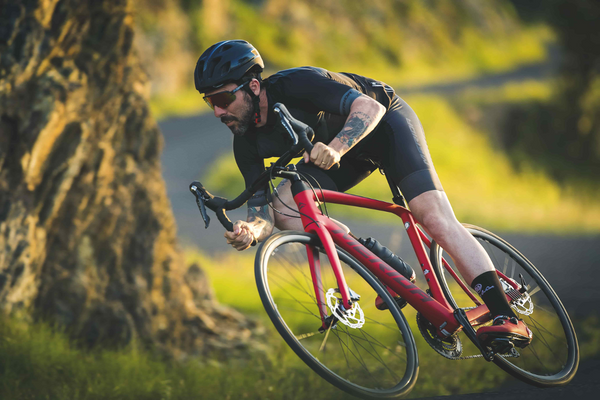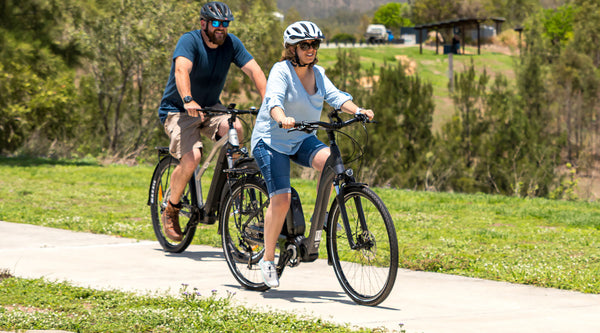If browsing through bicycle accessories online has become a hobby of yours, and you’re itching to elevate yourself from casual to serious cyclist, 99 Bikes is here to help! We cater to everyone in New Zealand’s cycling scene, and we love watching the progression from cycling enthusiast to full-on helmet head.
If you’re just getting into serious training for the first time, and wondering how you can train indoors, we have some tips that will help you build a comprehensive regime. Let’s get into it!
What Are You Tackling as a Cyclist?
Indoor and outdoor training aren’t actually that different, as long as you have a wind trainer and the dedication to push through. When it really comes down to it, any cyclist’s training plan needs to involve four key components:
- Endurance – how long you can keep riding.
- Speed – important for time trials and races.
- Strength – gears you up for tough hills and difficult terrain.
- Rest – without rest, your muscles can’t rebuild.
Training one of these aspects in isolation will lead to you becoming unbalanced. For example, if you constantly train strength, but you never train speed, competing in races or time trials will become very difficult. So how do you ensure you’re hitting each of these four components in your training, considering we all only have a certain number of hours in a week?
The trick is breaking your training plan into macro, meso, and micro-cycles.
Macrocycle: Setting Your Season Goals
Your macrocycle can also be called a season, and professional cyclists treat their training seasons like a race to the goal posts. They define a finish line and commit themselves to working toward this end goal. The key difference between people who cross that line and people who fall short is S.M.A.R.T goal setting.
Before you begin any endeavour, the most important thing is to set S.M.A.R.T goals. These are Specific, Measurable, Attainable, Relevant, and Time-bound goals that set you on a course to self-defined success.
- Specific goals are clear, giving you an unambiguous vision of what you’re working toward, in order to keep you motivated during the tough times.
- To avoid guessing at when you’re making progress, it’s important to use measurable metrics to track your goals! Indoor training with a wind trainer is helpful here, as it can track data for you.
- If a goal is too difficult for you to achieve in a given timeframe, or if it’s too far in the distance, mustering the motivation to work for it can prove impossible.
- A trap that many people fall into is creating goals for themselves based on what they think they should be doing, rather than what they want. Relevant goals should matter to you.
- Time-bound. Placing a time limit on yourself creates a sense of urgency, helping you to move faster and work harder when some grinding is needed. Luckily, cycling already lends itself to this aspect of goal setting, as race dates or events often dictate when you need to be ready.
Here’s an example, so you can see what a S.M.A.R.T goal looks like: “I want to achieve x racing time in x event that is in three months’ time”.
Mesocycle: Creating Training Blocks
If a season is a macrocycle, a mesocycle is about a month. Breaking down your season into several smaller blocks allows you to gradually increase the intensity of your workouts in a measurable, gradual way. This is crucial for healthy training, because you don’t want to overtax yourself (especially if you’re not used to evaluating how much you can take).
Within each mesocycle you’ll have a smaller goal to contribute to your overall goal. As you cross each smaller finish line, that sense of achievement and motivation will continue to snowball and carry you to your final goal!
Here’s an example of a mesocycle plan for a cyclist who’s brand new to training and looking to do their first endurance event in three months:
- Cycle One: Building Muscular Endurance. Early in your journey, building your fitness and muscular endurance is essential to conquering the rest of the season. So, start out by focusing on muscular endurance. If you want to experience the outside a little, pick up a bike rack for NZ’s beautiful outdoor trails, otherwise, you can up the intensity on your wind trainer (an essential component for indoor training).
- Cycle Two: Increasing Your Power Maintenance. Once you have a solid base of fitness, it’s time to build up the amount of power you can sustain for long periods of time. This helps you to ride strong and fast for long stretches of time. Many training cyclists pick up a digital display that allows them to track power output in watts, thereby helping to make the goal measurable.
- Cycle Three: Developing Your Anaerobic Capacity. Endurance events require you to keep going well past when your body wants you to give up, so developing your capacity to work with depleted oxygen in your muscles is key as you come up to the event day.
Micro-cycle: Building a Week of Training
Finally, you need to plan for each week of the mesocycle (cyclists call these micro-cycles). The best way to achieve your macro and meso goals is to begin each week with a micro goal in mind (e.g. I want to improve my threshold power to x this week).
It’s very helpful to have a set of workouts for each purpose (endurance, speed, strength, and recovery), and vary them throughout your cycle to achieve a well-rounded training program. It also reduces the time you invest in constructing your training plan each week, making you less likely to fall off the wagon.
- We recommend varying your workouts quite often to avoid stagnation. Try to build up a solid database of individual workouts in each area to plan from.
- Try to hit two intensity sessions a week. High-intensity work is anything above the anaerobic threshold, pushing your body to work harder and recover better. Don’t hit too many too fast, as this can wear you down significantly.
- Start out with a 90-10 split. Also called “polarised training”, this approach refers to dividing your weekly training time between normal and high-intensity training. 90% of the time goes to the former, 10% to the latter.
- Always plan time to recover. Whether you take a leisurely ride or choose to focus on your handling instead of your power, it’s crucial to take rest days to allow your body some recovery time.
Stay up to date with the best cycling gear, tips, and bicycle accessories online!
99 Bikes is proud to be the most approachable in-person and online bike shop in NZ! Whether you are brand new to the cycling world and want to know where to start, or you’re a pro looking for top-quality gear, we’ve got you covered. Shop our range today!





